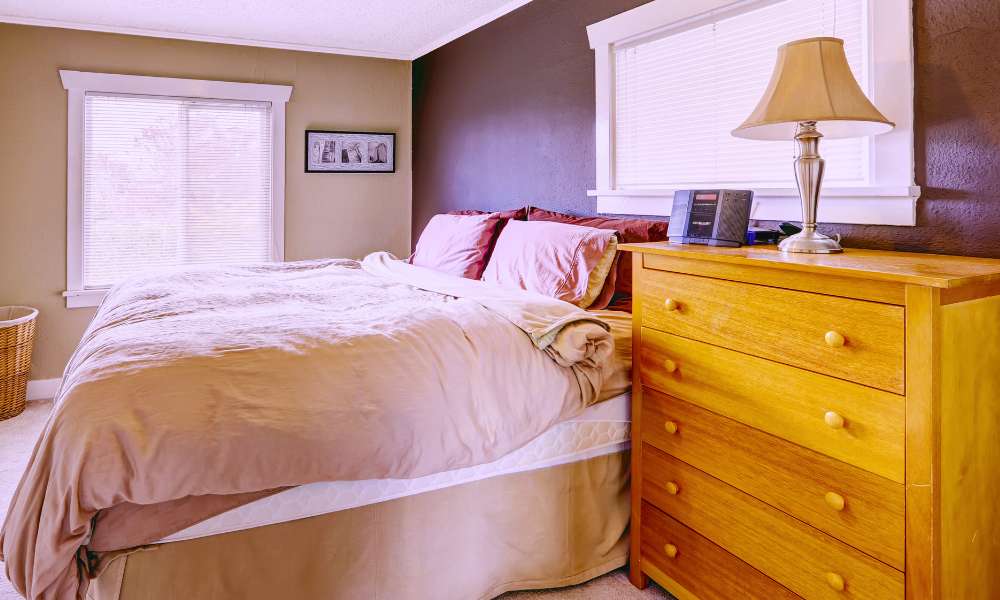When it comes to furnishing a bedroom, the nightstand is an essential piece of furniture that adds functionality and style. Choosing the right size nightstand for a queen bed is crucial to ensure it complements the bed and the overall aesthetics of the room. In this guide, we will explore the ideal dimensions for a nightstand in relation to a queen-sized bed and discuss various factors to consider when selecting the perfect nightstand.
How Wide Should The Nightstand Be For A Queen Bed?
The width of a nightstand for a queen bed is an important consideration. Typically, a nightstand should be proportionate to the width of the bed, maintaining a harmonious balance. As a general guideline, the width of the nightstand should be around two-thirds to three-quarters of the width of the queen bed. This range ensures that the nightstand offers enough surface area for essential items and visually complements the bed without overwhelming the space.
What Size Nightstand For Queen Bed?
The size of the nightstand for a queen bed is determined by its height, width, and depth. While there are no fixed dimensions, a standard nightstand for a queen bed usually ranges between 22 to 30 inches (56 to 76 cm) in height, 18 to 24 inches (46 to 61 cm) in width, and 16 to 20 inches (41 to 51 cm) in depth. However, these measurements can vary based on personal preferences, the style of the nightstand, and the available space in the bedroom.
Importance Of Nightstand Proportions

Maintaining proper proportions between the nightstand and the queen bed is essential for a cohesive and visually appealing bedroom design. When the nightstand is proportionate to the bed, it creates a balanced and harmonious look, enhancing the overall aesthetics of the room. Proportions also play a crucial role in ensuring that the nightstand serves its functional purpose without overwhelming the available space.
Bed Size And Nightstand Dimensions

Considering the size of the bed is crucial when determining the dimensions of a nightstand. A queen bed measures approximately 60 inches (152 cm) in width and 80 inches (203 cm) in length. To maintain balance, the nightstand’s height should be around the same level as the top of the mattress or slightly lower. The width and depth should be chosen based on personal preferences and the available space in the bedroom.
The Golden Ratio In Furniture Arrangement

The golden ratio is a mathematical concept that has been applied to art and design for centuries. It can also be used to achieve aesthetically pleasing furniture arrangements. Applying the golden ratio to the nightstand and queen bed relationship involves dividing the width of the bed by approximately 1.618 (the golden ratio) to determine the ideal width of the nightstand. This technique can help create a visually pleasing and balanced composition.
How To Choose The Perfect Nightstand
When selecting a nightstand for a queen bed, several factors should be taken into account:
1. Height Considerations

Ensure that the nightstand’s height aligns with the mattress or is slightly lower to allow for easy access to items on the nightstand.
2. Width Considerations

The width of the nightstand should be two-thirds to three-quarters of the width of the queen bed to maintain proportionality.
3. Depth Considerations

Consider the depth of the nightstand to ensure it provides enough surface area for items without protruding too far into the room.
Space Management Around The Bed
The space around the bed is crucial for functional and aesthetic purposes. Here are three approaches to space management with nightstands:
1. Keeping Balance With Dual Nightstands

Using two identical nightstands on either side of the bed can create a symmetrical and balanced look, providing equal storage and surface area for both sides of the bed.
2. The Solo Nightstand Strategy

If space is limited or you prefer a more minimalistic look, using a single nightstand can be an effective solution. Just ensure it is placed on the side that best suits your needs.
3. Style And Design Factors

Consider the overall style and design of the bedroom when selecting nightstands. They should complement the bed, other furniture pieces, and the overall theme of the room.
Material Choices For Nightstands
Nightstands are available in various materials, each offering its unique aesthetic and characteristics. Some common options include:
1. Wood Nightstands

Wood nightstands provide a timeless and classic look. They come in different finishes, such as oak, walnut, or cherry, offering a range of styles to suit various bedroom designs.
2. Metal Nightstands

Metal nightstands can add a contemporary and industrial touch to the bedroom. They are often sleek and minimalist in design, suitable for modern or eclectic decor styles.
3. Glass Nightstands

Glass nightstands can create an elegant and airy feel in the bedroom. They are especially suitable for smaller spaces as they visually take up less visual space.
Frequently Made Mistakes When Choosing A Nightstand
When selecting a nightstand, there are a few common mistakes to avoid:
- Choosing a nightstand that is too tall or too short compared to the bed, disrupting the visual balance.
- Opting for a nightstand that is too wide, leaving limited space to move around the bed or making the arrangement feel overcrowded.
- Neglecting to consider the overall style and design of the bedroom, resulting in a nightstand that clashes with the existing furniture and decor.
Can I Use A Short Dresser As A Nightstand?
In some cases, a short dresser can be used as a nightstand if its dimensions and proportions are suitable for the bed and the available space. However, it’s essential to ensure that the dresser’s height and width align with the guidelines mentioned earlier. Additionally, consider the dresser’s design and functionality to ensure it meets your specific needs as a nightstand.
The Final Thoughts
Choosing the right size nightstand for a queen bed involves considering the proportions, dimensions, and overall style of the bedroom. By following the guidelines and considering personal preferences, you can select a nightstand that complements the bed, adds functionality, and enhances the overall aesthetics of your bedroom. Remember to balance style, proportion, and practicality to create a harmonious and visually pleasing space.
